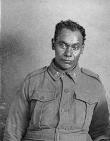Douglas Grant, Aboriginal draughtsman and soldier, was born in the Bellenden Ker Ranges, far north Queensland. In 1887, when Grant was an infant, his parents were said to have been killed in a tribal fight in Northern Queensland. In the article Pure Aboriginal Reared as White Man published in The Mail newspaper noted that Grant was saved from been murdered by an intoxicated Aboriginal trooper. However, Ramsland and Mooney suggest that it is more plausible that Grant's parents were killed by a punitive expedition of white settlers and native police launched from the colonial outpost of Cairns. Whatever occurred it resulted in Grant (then aged two) being rescued by Robert Grant and E.J. Cairn, members of a collecting expedition from the Australian Museum. The child was sent to Robert Grant's parents in Lithgow, New South Wales, and was later adopted by Robert Grant and his wife. Raised as Douglas Grant, his legal name, with Robert's own son Henry he received a good education at Annandale, Sydney, and trained as a draughtsman. He became an astute penman and sketch artist, winning first prize for a drawing of the bust of Queen Victoria at the Queens' Diamond Jubilee exhibition of 1897. He also learnt taxidermy from his adoptive father.
After 10 years of being a draughtsman at Mort's Dock & Engineering Co. in Sydney, Grant resigned in 1913 to work as a wool-classer at Belltrees station, near Scone, New South Wales. After World War I had broken out, Grant volunteered for active service in January 1916, enlisting as a private in the 34th Battalion, Australian Imperial Force (AIF). However, due to regulations preventing Aborigines from leaving the country without the approval of the Federal Government, Grant was discharged. He enlisted as a private a second time, and on 22 August 1916 embarked for France to join the 13th Battalion. On 11 April 1917 during the first battle of Bullecourt, Grant was wounded and captured by the Germans. He was held as a POW in the Wittenburg camp and later at Wundorf camp near Berlin until the end of the War.
During his incarceration, Grant became an object of curiosity due to his Aboriginality. He was physically examined by German doctors, scientists and anthropologists and was given relative freedom of movement within the compound. Grant's bust was even modeled in ebony by the distinguished German sculptor, Rudolf Markoeser. Between April 1917 and December 1918 the German prison camp authorities, after recognising Grant's ability as a well-educated leader and accomplished organiser and administrator, became president of the British Help Committee. Ramsland and Mooney have recorded that, in this position, Grant organised and supervised essential food parcels, comforts and medical supplies for distribution to the large number of Indian prisoners inside the Halbmondlager POW camp for 'coloured' soldiers in Zossen outside of Berlin...he was instrumental in saving many lives'.
After the cessation of hostilities, Grant was repatriated in December 1918 from Germany to England; there he visited his adoptive parents' relatives in Scotland. Grant attracted much attention in Scotland due to his Indigenous features combined with a richly burred Scottish accent. From England, he embarked on the troopship for Australia and arrived in Sydney on the 12 June 1919. He was discharged on the 9 July and returned to Mort's Dock & Engineering Co. to work as a draughtsman.
Several years later Grant moved to Lithgow, where he worked as a labourer at a paper products factory and later at the Lithgow Small Arms Factory. During this period, Grant kept active in returned servicemen's affairs and conducted a 'Diggers session' on the local commercial radio station. In the early 1930s by which time both his foster parents and brother had died, Grant returned to Sydney. Alone, and with his fame as a war hero dissipated, he obtained an obscure position as a clerk at the Callan Park Mental Asylum, where he also lived. Never marrying, he spent most of his spare time constructing a large ornamental pond spanned by a replica of the Sydney Harbour Bridge.
After World War II, Grant lived in the Salvation Army's old mens' quarters in their Home in the northern beach Sydney suburb of Dee Why and from 1950 at La Perouse. He died in Prince Henry Hospital, Little Bay and was buried at Botany Cemetery.
(Source: The Mail 31 October 1925; Australian Dictionary of Biography website: adb.anu.edu.au; Remembering Aboriginal Heroes 2006; Red Cross Society Wounded and Missing Enquiry Bureau files 1914-1918 War; Australian War Memorial: First World War Embarkation Roll - Douglas Grant )
 8897989847206464372.jpg
8897989847206464372.jpg

